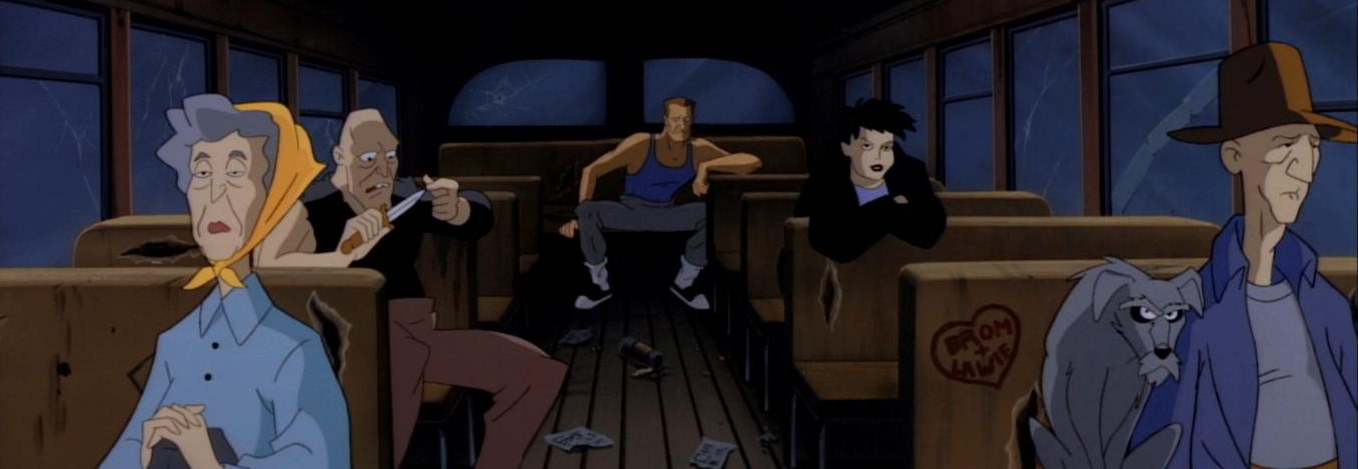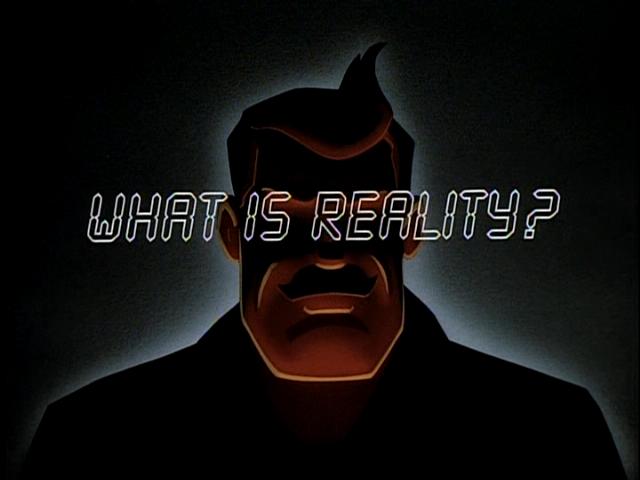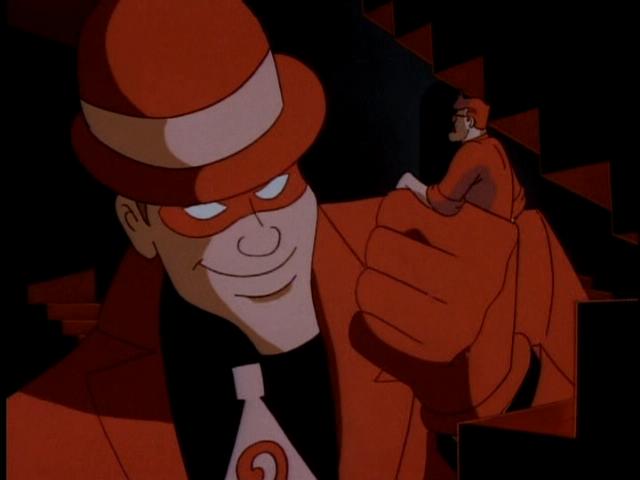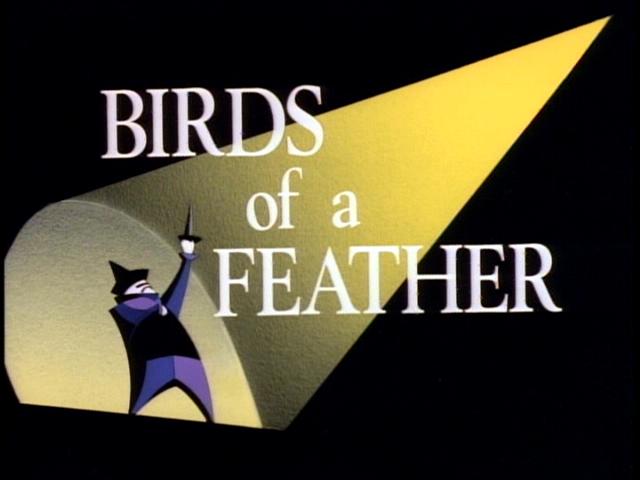“Birds of a Feather”
Story by Chuck Menville
Teleplay by Brynne Stephens
Directed by Frank Paur
Episode #047
Music Composed by Shirley Walker
Animation Services by Dong Yang Animation Co., LTD.
Original Airdate—February 8th, 1993
Plot: Heiress Veronica Vreeland woos the Penguin. The Penguin thinks it might be love, but Veronica and her friend Pierce are only using the Penguin to cause a stir among the upper crust.
“Birds of a Feather” is one of the more tragic episodes of Batman: the Animated Series, the first of a series where one of Batman’s established villains is given the opportunity to go straight, and inevitably rejects it. For as many as he’s in, “Birds of a Feather” is the only episode that’s actually about the Penguin. Usually he is the villain when the plot calls for any Batman villain. This is the only episode that could only work with Oswald Chesterfield Cobblepot.
The Penguin is the Batman villain with pretensions of culture, who sees himself as a “true elite” with “impeccable taste.” None of the other rogues would be tempted away from a life of crime by the promise of nights at the opera and hob-nobbing with politicians. The other villains would only see the rich and beautiful Veronica Vreeland as a target, not a friend. The Penguin’s problem is that he sees her as both.

Throughout the episode, the Penguin flips between willful self-delusion and painful honesty. He tells the prison guard that a limousine will be waiting for him but he knows his place is on the bus with the old, the deranged, and Hopey from Love and Rockets. He tells himself that a surprise party is waiting in his empty, dusty apartment, but he’s genuinely shocked when the phone rings. He outright accuses Veronica of using him for some purpose, but he so wants to believe that this woman is attracted to him that he fools himself into thinking she has no ulterior motive.

This episode goes out of its way to show us the Penguin as a human being with feelings. Paul Williams kills in this episode, especially the Penguin’s childlike disbelief that Veronica is actually inviting him to a party, and his anguished cry when this crime, this time, fails. Frank Paur’s direction evokes our pity at almost every turn. The Penguin looks so sad coming home to his empty, dusty apartment, and so giddy when he convinces himself that Veronica might be on the level. Even at the end, when he’s kidnapped Veronica, we can see he’s acting out of frustration and grief as much as plain old greed.
Veronica Vreeland (Marilu Henner) becomes a recurring character after “Birds of a Feather,” taking the place of Lisa Clark as Bruce Wayne’s friend, as opposed to a co-worker or an ally of Batman. She’s not quite bright and her commitment to charity only goes so far as throwing great parties, but she’s not malicious either and she’s capable of learning.

Unlike, say, Pierce Chapman, who’s drawn as upper class twit and voiced by Sam McMurray as Thurston Howell III. Pierce is a sociopath in the Batman: the Animated Series tradition, a rich man who uses and abuses those he can’t conceive of as human beings. At least this time the target of his abuse is an established criminal, and he didn’t end up creating a new rogue.
Of course, Pierce doesn’t care about being robbed. Crime is apparently so common in Gotham that the rich expect to robbed once a year, muggers assume their victims “know the drill,” and Pierce calls a million dollar ransom “petty cash.” No wonder the Penguin doesn’t understand that he shouldn’t eat at restaurants he’s robbed, or remind bank presidents of the weaknesses in their vaults. To the Penguin, at least, it’s all part of the game.
Part of the tragedy is that the Penguin doesn’t realize who really cares about him. While no other crooks show up to welcome Penguin home (specifically, none of his poker buddies), Batman does. In the whole world, Batman is the person who cares about the Penguin the most, and if the Penguin didn’t hate Batman, maybe he’d see that. Notably, when Batman approaches the Penguin as Bruce Wayne, Oswald Cobblepot immediately opens up. We can see that, had things worked out only slightly differently, he might have gone straight for good.

Shirley Walker’s score takes the tragic themes and opera setting of the last act and runs with it. From the opening title card to the Penguin’s Wagnerian flying dragon, the music references high opera and low. And of course the Penguin’s favorite opera is Pagliacci. While the story of killer clown might also appeal to a different rogue, Pagliacci is the story of a man betrayed by the woman he loves who flies into a murderous rage when confronted by the truth. No wonder Mr. Cobblepot can’t help singing along.

“What is Reality?”
Written by Marty Isenberg, Robert N. Skir
Directed by Dick Sebast
Episode #048
Music Composed by Richard Bronskill
Animation Services by Akom Production Co.
Original Airdate—November 24th, 1992
Plot: The Riddler returns to wipe out any evidence of his existence, and lures Batman into a virtual reality labyrinth to save the life of Commissioner Gordon.
Once again, the title of a Riddler episode is a question. But this time, no one within the episode actually asks the question “What is Reality?” Instead, it’s a constant question in the episode itself, which maybe reflects the computer security concerns of 1992 and a villain who seems to be able to hack any computer in Gotham. What’s the difference between money in your ATM account and cash in hand? What’s the difference between physical and digital files? What is the difference between a real and a virtual spin in a centrifuge, if both will kill you?

And why does the Riddler return?
The Riddler claims it’s to erase any evidence of his previous life as Edward Nygma and to kill Batman in his virtual reality machine, and both answers are good, but neither suffices. Nygma uses the threat of his machine to sneak his goons into Police Headquarters to get his files, but then he uses the theft of files from the DMV to distract Batman while he captures Gordon. But if the police can’t find the Riddler, why would it matter if they have records on him, and what good would deleting the files do if every cop remembers the Riddler’s birthname? Additionally, if the Riddler really wanted to kill Batman, why doesn’t he fry Bruce’s brain the moment he puts on the VR helmet? Each reason Nygma gives is a misdirection for the other, and both hide his true goal.
Like the Penguin, the Riddler is only really interested in the game. Exactly as he did in “If You’re So Smart, Why Aren’t You Rich?” the Riddler has kidnapped someone just to force Batman to run a maze. The big difference is this time the “maze” is virtual, and the Riddler can fulfill his true destiny as a 5th dimensional imp, effortlessly weaving the landscape around him into surrealist patterns. Nygma bases his imaginary world on the works of Escher, Tenniel, and Dali. Everyone, especially Robin, is very impressed with the Riddler’s ability to create a believable world inside a computer, which means a) “Riddle of the Minotaur” looks even crappier in comparison and b) clearly no one saw the Mad Hatter’s dream making machine or Hugo Strange’s mind reading device.

The Riddler and video games go together like peanut butter and jelly, especially 3D platform games. There’s the constant voice of disapproval, watching and taunting you through the game (John Glover is even better in this episode than his first, more teasing and always so very, very calm). There’s a mixture of physical and mental challenges. There’re set piece battles that lead one from the other with little explanation, just because he wrote a chess puzzle and a constellation puzzle, and wanted to use both. The Joker’s the more famous villain, so he’s usually the big bad of any Batman video game, but it really should always be the Riddler. (In fact, there’s an argument that the Riddler really is the main villain of Batman: Arkham Asylum, an idea that’s further developed in Arkham City, where the Riddler takes over all of the bonus levels.)
My only problem with this episode is the resolution. Not Batman doubling his avatar and tricking the Riddler into breaking his world, another good example of beating the Riddler by refusing to play his game. I have a problem with the Riddler getting caught in his own game. Like the Joker tripping on a banana peal, it’s victory for Batman through dumb luck rather than actual skill. I guess there was a note that the Riddler couldn’t get away after beating Batman twice.

Steven Padnick is a freelance writer and editor. By day. You can find more of his writing and funny pictures at padnick.tumblr.com.











“Birds of a Feather” — I agree completely. A great Penguin story, and the best use of his character in the series. And Veronica was a great addition to the ensemble, very well played by Marilu Henner.
“What is Reality?” — Ugh. I’ve commented before on how lame the riddles are in the first two Riddler episodes, but the ones at the start of this one are the worst. I disagree that computer-game/VR stories are a good fit for the Riddler, maybe because I don’t play computer games; it just felt to me like an attempt to modernize the character and make him more action-oriented, and it seemed like dumbing him down. Plus Akom’s cruddy animation further diminishes the episode. A VR episode could’ve been impressive despite its story weaknesses if it had been skillfully animated, but no such luck.
I loved “Birds of a Feather”, and I also loved “What is Reality?” – of course, I was a little kid, when I saw it, and receptive for the surrealistic virtual world.
Birds of a Feather is one of my favorite episodes. I recall the tie-in comic had a Dini and Timm-created special (first (non-animated) appearance of Roxy Rocket) which explored other cases where the baddies tried to go good. The Scarecrow, Harley, and (most tragically) the Ventriloquist.
…I never liked TAS Riddler episodes. Would you hate me if I said The Batman did the character far, far better?
@3: That comic wasn’t just the first non-animated appearance of Roxy Rocket, it was her first appearance, period. She was created by Paul Dini for the tie-in comic years before her first screen appearance in The New Batman Adventures.
And yes, The Batman‘s Riddler was pretty effective. Stan Berkowitz (a writer for the later DCAU shows) wrote the Riddler’s origin-story episode for that series, and it was a more B:TAS-like story than that of the actual B:TAS Riddler.
That’s what I meant, because many people fans only seem to know her from the show, with no idea she’d turned up in Adventures previously.
@5: I bet a lot of people are also unaware that “Holiday Knights” and “Mad Love” were one-shot specials of the tie-in comic first, and only later adapted to TV. Although “Holiday Knights” left out a really nice Mr. Freeze story that was part of the original Christmas Special comic.
The Penguin episode was decent–not great but worth watching–but the Riddler episode was just awful. It’s chock full of lame riddles, the plot is nonsensical, the animation is bad–it’s definitely near the top of my “least favorite episodes” list.
The animation in “What Is Reality?” wasn’t the best, but overall, I in no way found this episode lame. I actually really liked what they were doing with Riddler’s character and his connection to computer games. And the surrealistic computer-generated world was quite impressive anyway.